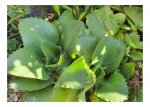C
Hey guys. I've got this growing in pots and in my garden. It's spread out through pups. Can you tell me if it's the Kataka-taka plant, which apparently is prevalent in the Ph and sometimes called the miracle plant, please? If it is, would you mind telling me what it is useful for, please. Shalom.
Attachments
-
897.5 KB Views: 14
-
978.8 KB Views: 14
-
830.4 KB Views: 14
-
1
- Show all




